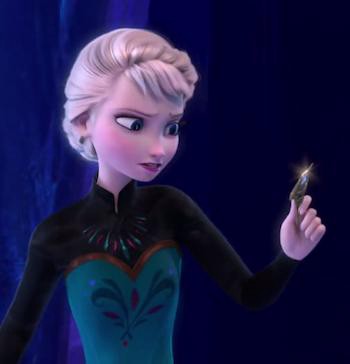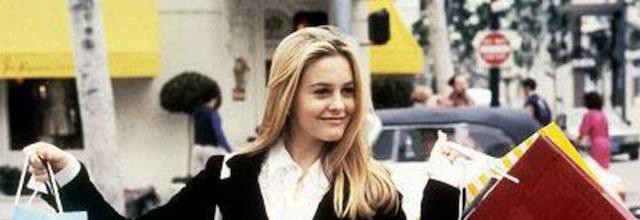Elsa’s Coming Out Party
by Ester Bloom

In a world of pretentious dude film critics, Dana Stevens stands out as an acute observer and an approachable intellectual with a sense of humor, and we are grateful for her for all she does. But every once in a while a reader has to say, “WTF?” As in, “WTF? Dana Stevens hates movie makeovers?”
In discussing Frozen, about which she is generally positive, Stevens expressed dismay about the Oscar-nominated power ballad “Let It Go,” during which Elsa transforms from Disgraced Princess to Ice Queen:
“That perfect girl is gone,” she declares as she ditches her old look (a modest dark-green dress and purple cloak, hair in a neatly tucked-up braid) for one that’s arguably even more “perfect.” By the time she sashays out onto that balcony to greet the dawn, Elsa is clad in a slinky, slit-to-the-thigh dress with a transparent snowflake-patterned train and a pair of silver-white high heels, her braid shaken loose and switched over one shoulder in what’s subtly, but unmistakably, a gesture of come-hither bad-girl seduction…
I know I’m not the only one who feels a familiar sense of deflation every time that pulse-racing song (delivered so gloriously by Menzel) culminates in a vision of female self-actualization as narrow and horizon-diminishing as a makeover.
On some level, this feels like Second Wave Feminism wrinkling its nose at the Third Wave. Elsa ditches her “modest” high-necked, full-coverage dress for a flashy high-femme number, and Stevens groans that Elsa feels she needs high heels and a slitted skirt to fit her new identity. As someone who leaves the house in flats and with the minimum amount of makeup necessary to be allowed entrance to the island of Manhattan, I sympathize with her discomfort. But I also encourage Dana Stevens to embrace her inner Cher Horowitz and remember the power a makeover can have, especially for an uneasy adolescent girl coming to terms with herself for her own sake.

The trouble is, Elsa’s old dress is not “fine”; it is associated too strongly with the normal, obedient girl Elsa had to pretend to be for too long (“Be the good girl you’ve always had to be / Conceal, don’t feel, don’t let them know / But now they know…”). The buttoned up look was appropriate for someone dressing to please her parents and who needs to be protected from the elements. As Elsa confesses, once she starts belting out her real feelings, “The cold never bothered me anyway.”
Elsa’s unusual power adds another element to what could be a straightforward coming-of-age story: it also becomes one of coming out. Her whole life she has been told to hide, to pretend that she is like the rest of us, because her truth is too frightening for the world to accept. She cannot even share her secret with her sister. Sure enough, when she loses control and exposes herself, people recoil in fear. In short, Elsa is a mutant, and this movie, like the X-Men franchise, is a not-so-subtle allegory about sexuality.
Her whole life, Elsa has been closeted, though since she is a princess, her closet is a vaulted chamber large enough to hold a ball. Once her secret is out, Elsa follows suit, and like many adolescents leaning into something about themselves about which they were previously ashamed, she maybe overdoes it a little in reaction. In the makeover that Stevens finds alarming, Elsa goes for full-on drag queen fabulousness. She experiments with using her clothes to express — rather than repress — her bourgeoning sense of self: she can design and build snow castles, sing about fractals, and look hot doing it. When she lets her hair down, literally, and vamps it up for the camera, our reaction should be to cheer.
The same future EGOT-winners who gave Broadway Avenue Q and The Book of Mormon brought their very gay-friendly sensibility to Frozen. Elsa must be the only Disney princess in history to have no love interest, no man who woos her and wins her heart. When her sister Anna — the “sensibility” to Elsa’s “sense” — shares that she has gotten engaged to an adorable prince, Elsa reacts not with “OMG!” straight-girl squealing but with lesbian pragmatism: “You cannot marry a man you just met.” Tell that to Sleeping Beauty.
By the end of the movie, Elsa has embraced her uniqueness and rejoined society. Does she then make eyes with an alluring sailor, like your run-of-the-mill heterosexual? Uh-uh. She remains happily independent to the last. That is as subversive, gender- and sexuality-wise, as Disney can let itself be, but we know that in the sequel, Elsa will find herself a ladyfriend, possibly on the bobsled team at Arendelle University. For now, we can applaud her freedom and self-actualization.
One more clue, in case we needed it, to Elsa’s true identity: the hairstyle to which Stevens objects, the braid let down and thrown over one shoulder, is a nod to the most famous crypto-lesbian of them all, Katniss Everdeen.
Previously: For Emily M. Keeler, Who Interviewed the Prince of Pricks
Ester Bloom can apparently find the gay in anything, #SorryNotSorry. Follow her on Twitter @shorterstory.